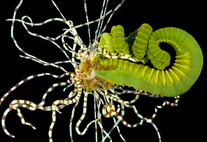Abstract
This comprehensive taxonomic work is the result of the study of fan worms (Sabellidae, Annelida) collected over the last 40 years from around the Lizard Island Archipelago, Great Barrier Reef, Australia. Some species described herein are commonly found in Lizard Island waters but had not previously been formally reported in the literature. Most species appear to be not particularly abundant, and few specimens have been collected despite the sampling effort in the area over this time period. After this study, the overall sabellid diversity of the archipelago has been greatly increased (by more than 650%). Before this revision, only four sabellid species had been recorded for Lizard Island, and in this paper we report 31 species, 13 of which belong to nominal species, six are formally described as new species (Euchone danieloi n. sp., Euchone glennoi n. sp., Jasmineira gustavoi n. sp., Megalomma jubata n. sp., Myxicola nana n. sp., and Paradialychone ambigua n. sp.), and the identity of 12 species is still unknown (those referred as cf. or sp.). Two species are newly recorded in Australia and two in Queensland. The invasive species Branchiomma bairdi is reported for the first time at Lizard Island. The genus Paradialychone is reported for Australia for the first time. Standardised descriptions, general photographs of live and/or preserved specimens and distribution data are provided for all species. New species descriptions are accompanied by detailed illustrations and exhaustive morphological information. A dichotomous key for sabellid identification is also included.

